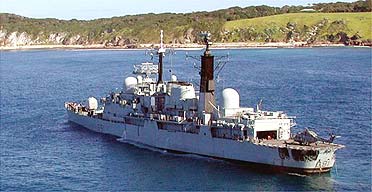Divers were today assessing the damage to a Royal Navy destroyer which ran aground off the south-east of Australia.
HMS Nottingham, a Type 42 destroyer, was holed below the waterline and took on water after hitting a rock near Lord Howe Island, 200 miles north-east of Sydney.
There were no reports of any casualties among the vessel's 253 crew, who remained on board throughout the incident.
British defence officials said the Nottingham struck rocks two nautical miles east of the island as it was transferring a sick crew member to shore.
"Having conducted that, the ship then turned back to sea and in doing so grounded on Wolf Rock," said Commander David Heley of the Royal Navy directorate of communications in London.
The collision produced a half-mile-long oil slick near the environmentally pristine island. The chief executive of the Australian waterways authority, Matthew Taylor, said the slick of light oil was being broken up by the propellers of small boats.
An inquiry will now be set up to establish whether the ship's captain, Commander Richard Farrington, should face a court martial.
The Australian air force today flew out heavy pumping equipment to the vessel and Australian navy divers were examining the extent of damage.
A spokesman for the British Ministry of Defence said that the 3,500-tonne ship was now stable and at anchorage off Lord Howe Island, having been successfully refloated.
"She has taken on water. There is a fair bit of flooding, we are trying to find out just how much there is," the spokesman said.
However, Ben Mitchell, of Australian Search and Rescue, said the incident had looked as if it could have been far more serious when the collision was reported by the Lord Howe Island's harbour master at 9.20pm local time.
"At that stage the situation was extremely serious and there were concerns the ship may sink," he said.
"Some consideration was given to beaching the vessel to prevent it sinking. The ship had been holed but the crew managed to stem the inflow of water and they got the situation under control."
Cmdr David Heley, who was in charge of HMS Nottingham's sister ship HMS Gloucester last year, said the vessel was on a routine trip from Cairns, in Queensland, north-east Australia, to Wellington, in New Zealand.
The destroyer, which is equipped with Sea Dart missiles, can carry out anti-submarine and anti-surface actions, and can also perform air defence operations for the fleet.
Cmdr Heley said it was "fruitless" to speculate on the causes of the incident until a Royal Navy inquiry had been completed.
He added that the Nottingham's commanding officer, Richard Farrington, had been in charge of the ship for 18 months to two years and would be in "good hands".
"He's a cool, phlegmatic individual. Obviously, this will be a major challenge but I have every reason to suspect he'll handle this incident with great professionalism," said Cmdr Heley.
The MoD denied claims by anti-nuclear protesters that the ship was escorting a consignment of nuclear fuel being transported from Japan to Britain.
The vessel left the UK in March this year and was due back in November or December.
